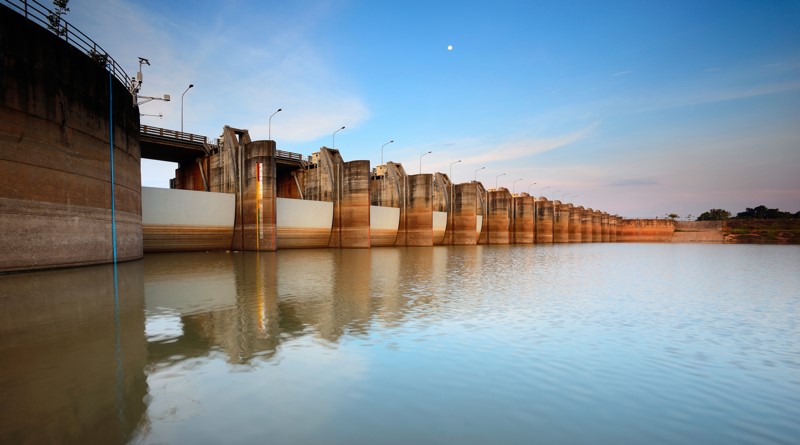World’s large dams could lose vital water storage capacity in coming decades

The world’s large dams could be of losing vital water storage capacity over the next three decades due to accumulation of sediments, seriously undermining water security, irrigation and power generation, a new research study by the United Nations has warned, adding that new dams under construction or planned across the world may not be enough to offset storage losses to sedimentation.
The study states that trapped sediment has robbed roughly 50,000 large dams worldwide of an estimated 13-19 per cent of their combined original storage capacity, and total losses will reach as much as 23-28 per cent by 2050.
The dams’ original storage capacity lost to sediment by 2050 could be 1.65 trillion cubic meters, roughly equal to the combined annual water use of India, China, Indonesia, France and Canada.
In India, as many as 3700 dams could lose 26 per cent of their total storage by 2050 due to accumulation of sediments, a warning that echoes a 2015 report by the Central Water Commission (CWC) that said among 141 large reservoirs which are over 50-years-old in India, one quarter had lost at least 30 per cent of their initial storage capacity.
In 2022, the Asia-Pacific region, the world’s most heavily dammed region, may have lost 13 per cent of its initial dam storage capacity. It will have lost nearly a quarter (23 per cent) of initial storage capacity by 2050, the study by the UN University’s Canadian-based Institute for Water, Environment and Health said.
The institute applied previously-determined storage loss rates in various areas worldwide to large dams in 150 countries to forecast cumulative reservoir storage losses by country, region, and globally.
The United Kingdom, Panama, Ireland, Japan and Seychelles will experience the highest water storage losses by 2050 – between 35 per cent and 50 per cent of their original capacities – the study shows. By contrast, Bhutan, Cambodia, Ethiopia, Guinea, and Niger will be the five least affected countries, losing less than 15 per cent by mid-century.
“The decrease in available storage by 2050 in all countries and regions will challenge many aspects of national economies, including irrigation, power generation, and water supply,” said Dr Duminda Perera, who co-authored the study with UNU-INWEH Director Vladimir Smakhtin and Spencer Williams of McGill University in Montreal.
“The new dams under construction or planned will not offset storage losses to sedimentation. This paper sounds an alarm on a creeping global water challenge with potentially significant development implications.”
The UN researchers applied previously-established storage loss rates worldwide to a subset of nearly 60,000 dams in a database maintained by the International Commission on Large Dams (ICOLD). The subset comprises 47,403 large dams for which original storage capacity and year of construction are known: 28,045 in Asia-Pacific, 2,349 in Africa, 6,651 in Europe, and 10,358 in North, Central and South America.
Large dams and reservoirs – defined as higher than 15 m, or between 5 and 15 m high impounding over 3 million m3 – are essential in many places for hydroelectricity, flood control, irrigation, and drinking water.
River sediment accumulates behind a dam’s barrier. The problem, often ignored, has now become a significant challenge to global water storage infrastructure that must be addressed with a long-term sediment management strategy.
“Sedimentation is a serious issue that endangers the sustainability of future water supplies for many,” said Dr Smakhtin.
“It stimulates downstream flooding causing erosion, impacting wildlife habitats and coastal populations. And abrasive sediments can damage hydroelectric turbines and other dam components and mechanisms, decreasing their efficiency and increasing maintenance costs.”
Global warming compounds the risk in ways that have yet to be fully measured.
“Climate change extremes like floods and droughts will increase, and higher intensity showers are more erosive,” Smakhtin said.
This not only increases the risk of reservoirs overflowing but also accelerates the build-up of sediment, which affects dam safety, reduces water storage capacity and lowers energy production in hydroelectric dams.
Global average annual storage losses amount to approximately 0.36 per cent of initial capacity, the UNU-INWEH study says, noting that figure may err on the conservative side. Previous attempts to estimate a global annual rate of loss from initial reservoir capacity generally agree on a range between 0.5 per cent and 1 per cent.
To address looming challenges of ageing dams and reservoir sedimentation, the study authors list several measures.
Bypass, or sediment diversion, can divert water flow downstream through a separate river channel. Another strategy is the removal, or “decommissioning”, of a dam to re-establish the natural flow of sediment in a river.
But addressing water storage issues is especially complex because there is no one-size-fits-all solution, Smakhtin said.
“The loss of water storage is inevitable for different reasons,” Smakhtin said. “So the question we should be asking is what are the alternatives?”



